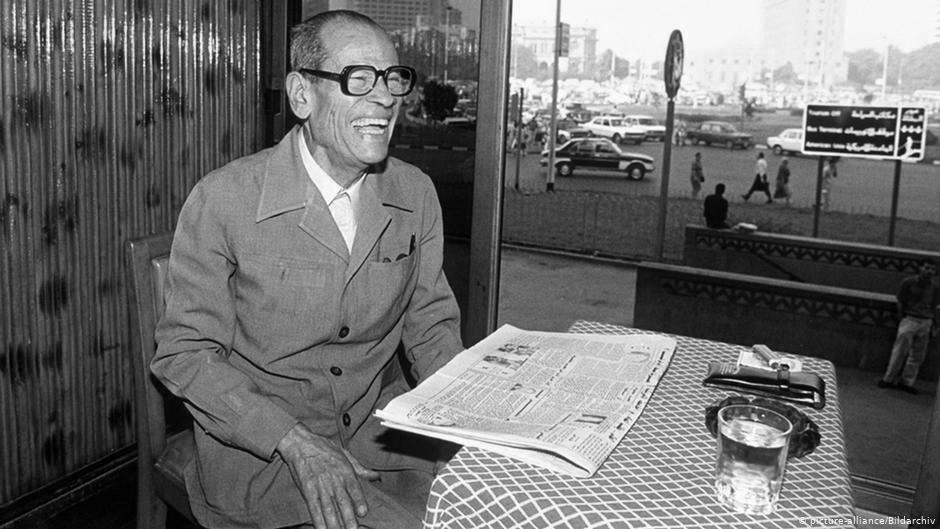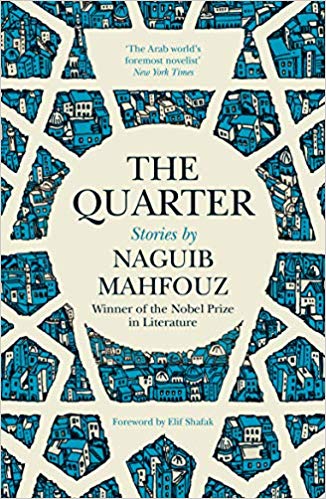Naguib Mahfouz' "The Quarter"

In fact Shoair made a number of intriguing discoveries. His first was in that dusty cardboard box. Inside, he found a folder with a note in Mahfouzʹs handwriting, suggesting the pieces within should be published in 1994.
Yet 18 of those works had never been released. It is unclear why, although we can guess: 1994 was the year of Mahfouzʹs near-fatal stabbing by a radicalised young engineer. After the attack, Mahfouz lost the use of his writing arm. His brief final works were dictated to others.
We canʹt know what Mahfouz intended to do with the fictions collected into The Quarter. He might have considered them complete and ready for publication, or they might have been the seeds of a new novel. But Shoair, who saw the masterʹs hand in them, encouraged Mahfouzʹs daughter to publish.
Fans of Mahfouzʹs best-known work, The Cairo Trilogy, might be surprised by The Quarter. Mahfouz is often represented as “the Egyptian Balzac” or, a bit ridiculously, “the Egyptian Dickens”.
But he was not only the author of the Trilogy. He was also the author of genre experiments, allegorical works, and studies in perspective. Toward the end of the twentieth century, Mahfouz was paring down his rich visual and psychological landscapes. His fictions grew progressively less about the material world, and more about the unseen.

Part folktale, part Sufi koan
This new folio of interconnected stories is very much part of Mahfouzʹs late experiments. There are no sophisticated characters in The Quarter. There is no self-reflective Kamal Abd Al Jawwad, nor a guilt-ridden Mansour Bahi. The geographical and historical specificity disappear. We are in "the Quarter", but there is no particular Egyptian landmark or well-known event.
Indeed, the stories in The Quarter – part folktale, part Sufi koan – are anti-national in outlook. There are bigger places outside the Quarter: Europe, Zamalek… and wherever the Health Inspector comes from. But the Quarter is not tied to a national or regional history.
At the end of the collection, Saqi editors have slipped in Mahfouzʹs Nobel acceptance speech. Although Mahfouz didnʹt give this 1988 talk in person, it illuminates the aspirations of The Quarter. The speech gives a nod to the Nobel while also provincialising it.
Although Mahfouz did not like to travel, his speech is deeply international, throwing light on the injustices of both apartheid South Africa and Palestine.
The works in The Quarter, presumably written between 1988 and the attack in 1994, feed off this universality. They also abandon many Western genre conventions. Time is out of joint, disasters come from nowhere, and events are almost never logically explained.
ʹThe disaster had happenedʹ
The first story, "The Oven", is framed like a moral allegory. It opens: "The disaster had happened."
The disaster in question is an elopement: a wealthy merchantʹs daughter runs off with the bakerʹs son. We know what the neighbourhood thinks: "Down every alleyway, at least one good heart expressed disbelief[.]" But we donʹt know what Ayousha, Zeinhum, or their parents feel about it.
In folktale fashion, the shamed merchant falls on hard times and his daughter returns to save her family from financial ruin. Yet the story doesnʹt end in sentimental reconciliation. Instead, the end belongs to the Quarterʹs two central authority figures: the "Head of the Quarter" and the "mosque Imam". They step on stage to give their opinions, like narrators at the end of a play. The Head remarks that there is "no need" to forgive the girl, because sheʹs come in time. Mercy is thus granted not because of her actions, but because she arrived "at just the right moment."As the collection progresses, stories become less like Sufi folktales and more like mystical puzzles. "The Prayer of Shaykh Qaf" is a murder-mystery in which we know the who, what, and why from the first seven sentences. The apparently guilty party confesses, and our story seems complete. But somehow, the quarterʹs "hidden tongue" spreads it about that the confession is false.
The Head of the Quarter is troubled and visits the home of Shaykh Qaf, who seems to know who did it. The two men exchange cryptic comments, shake hands, and Shaykh Qaf says, meaningfully, that he hopes heʹll see the Head of the Quarter again. Thus, a story that began in clarity ends in mystery.
Throughout the collection, rational causality is dethroned in favour of unexplained tragedy. Sandstorms blow up, arrows are shot out of nowhere, hidden tongues speak hard truths, and wild brawls rage. At one point, there is an epidemic of weeping with no apparent cause.
The weeping comes in "Your Lot in Life". This storyʹs opening phrase re-makes the Arabic folktale formula. A traditional tale might begin kan ya ma kan fi qadim az-zaman, "it was or it wasnʹt in the oldness of time." Mahfouzʹs story opens: "We do not know precisely when the phenomenon began to occur. All those who witnessed it have their own version. Time lost its order."
The translation has a few extra words that could have been tightened out. But by and large, itʹs smooth reading.
The laughter cure
In "Your Lot in Life", unexplained weeping troubles the quarter. The Imam suggests "hot baths and cold drinks" will remedy the mass weep-in, while an old woman insists exorcism is the cure.
Finally, the Health Inspector arrives. He goes door to door, turning up nothing. Finally, exhausted, he goes to rest with a local musician. The people hear the musician sing, "Your lot in life is bound to find you…" Soon, the epidemic of weeping ends. This is not thanks to hot baths and cold drinks, exorcism, or the Health Inspectorʹs investigations. Instead, itʹs thanks to the music that: "They all dissolved into laughter."
Irreverence, laughter, and music provide the small joys of this collection. The Imam tells an orphan truth-teller "go back to your mosque", and the 10-year-old cheekily turns the same phrase back on him: "You go back to your mosque!" In addition to the curative musician in "Your Lot in Life", we also hear Munira, Abd al-Hayy, Beethoven and Sayyid Darwish.
Music, after all, might be the most universal form of communication. A song can be appreciated in the Quarter and in Europe, by the Health Inspector and by the old woman. In the end, Mahfouzʹs The Quarter leans heavily on these non-verbal intertexts. And while it might not be the complete work he intended, it is a compelling experiment in sound and echo.
Marcia Lynx Qualey
© Qantara.de 2019